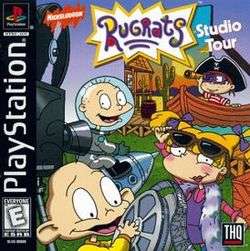Rugrats: Studio Tour
| Rugrats: Studio Tour | |
|---|---|
 North American cover art | |
| Developer(s) | n-Space |
| Publisher(s) | THQ |
| Composer(s) | Mark Mothersbaugh |
| Series | Rugrats |
| Platform(s) | PlayStation |
| Release date(s) | |
| Genre(s) | Action-adventure |
| Mode(s) | Single-player |
Rugrats: Studio Tour is a 1999 PlayStation game based on the Nickelodeon television series Rugrats developed by n-Space and published by THQ.
Plot
While on a trip to a movie studio, Tommy, Chuckie, Phil, Lil, Angelica, Susie, and Dil venture away from the grownups. But in the process, Dil gets locked behind a door, and the security guard loses the keys to the door thanks to Dil himself, forcing the others to venture throughout the studio and explore various film sets in search of the keys to free Dil from an adventure film set before he is harmed by the props.
Gameplay
The player chooses from five available attractions in the search for keys that include:
- Captain Cookies: A pirate-themed attraction where the player controls Angelica. A golf and footracing game is included.
- Outside Space: A space-themed attraction where the player controls Chuckie. It includes a series of platforming levels, a moon exploration, and a shooting gallery.
- Lazy Saddles: A western-themed attraction where the player controls Susie. The levels here involve collecting gold, rounding up animals, golf, and a shooting gallery.
- Diapies of Thunder: A racing-themed attraction where the player controls Phil. The levels here are all racetracks that require a certain number of laps to be completed. The attraction name is a reference to the film Days of Thunder.
Once the player completes a level in any of the attractions, they are awarded with a key. A key is also rewarded if the player collects enough Reptar bars.
Reception
Cal Nguyen of AllGame rated the game two and a half stars out of five, and compared it to Rugrats: Search for Reptar, writing, "It's basically the same game in a newer arena." Nguyen criticized the game's "clumsy controls" and wrote that certain parts of the game "seem to be very boring due to the lack of tasks to do. The basic purpose for most levels is to collect Reptar bars and other items needed to complete the levels. Sounds simple, huh? Well, it's simple yet frustrating after you've fallen off a bridge or you've gotten lost in the sprite-based textures of a gigantic maze." While Nguyen criticized the game's "average" graphics, he also considered them to be a slight improvement from Rugrats: Search for Reptar. Nguyen also said that the game's map display "looks horrible with only a transparent outline on the screen. As well, you have to continue discovering new areas in order for the map to fill itself out, so to speak. But when you "die" it starts all over again; it's pretty easy to get lost in this game!" Nguyen called the game "dull and silly", and wrote that "the mini-golf games are probably the only tolerable levels in the game." However, Nguyen also wrote, "There is actually variety in the game due to the various levels that have different goals and purposes, which are fun in their own way," and, "The sound effects and music are good while the voiceovers are superb, even though they are a bit annoying."[1]
See also
References
- ↑ Nguyen, Cal. "Rugrats: Studio Tour Review". AllGame. Archived from the original on November 15, 2014.